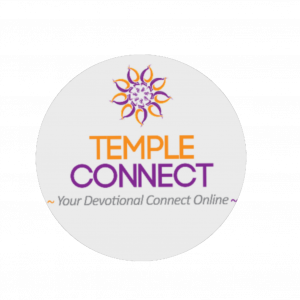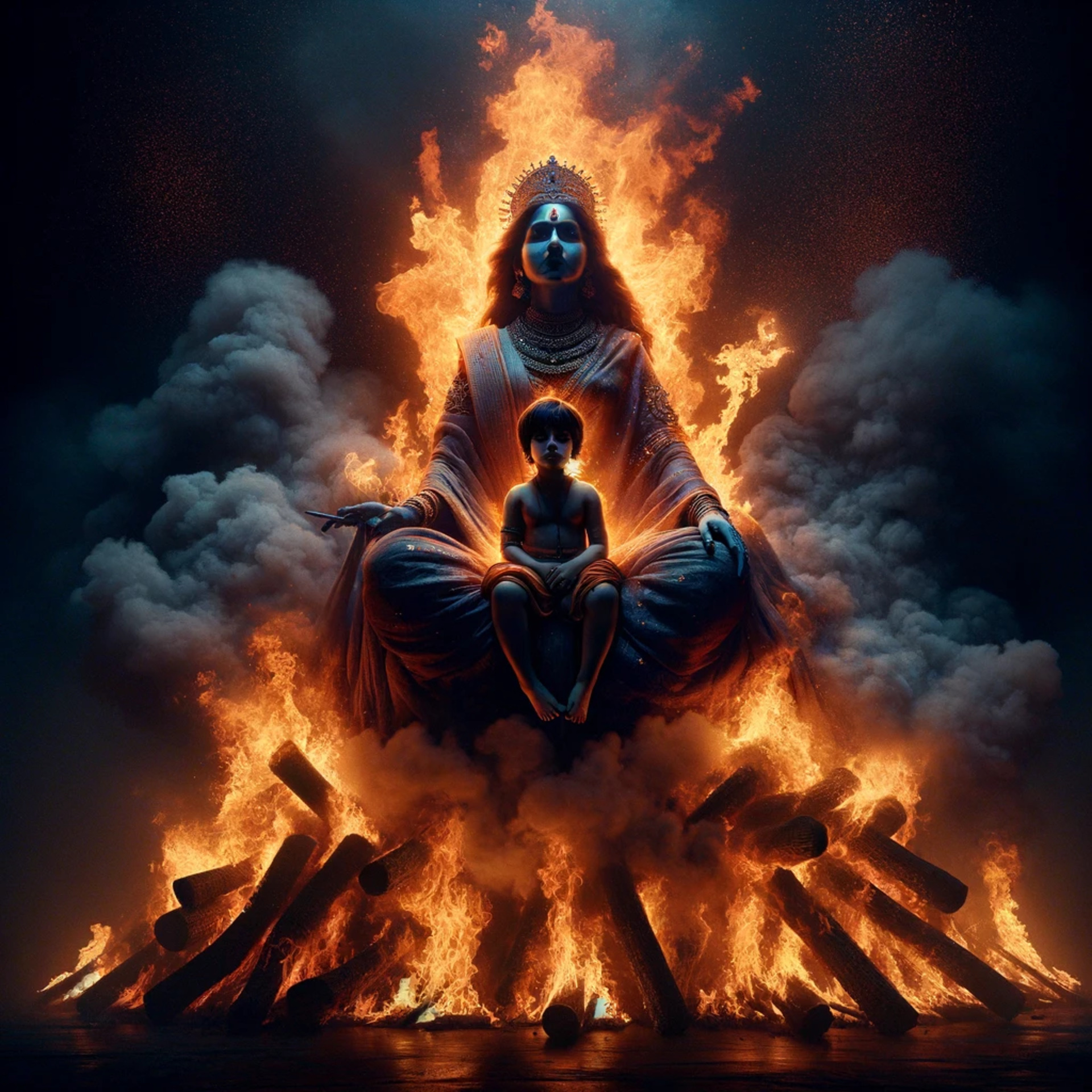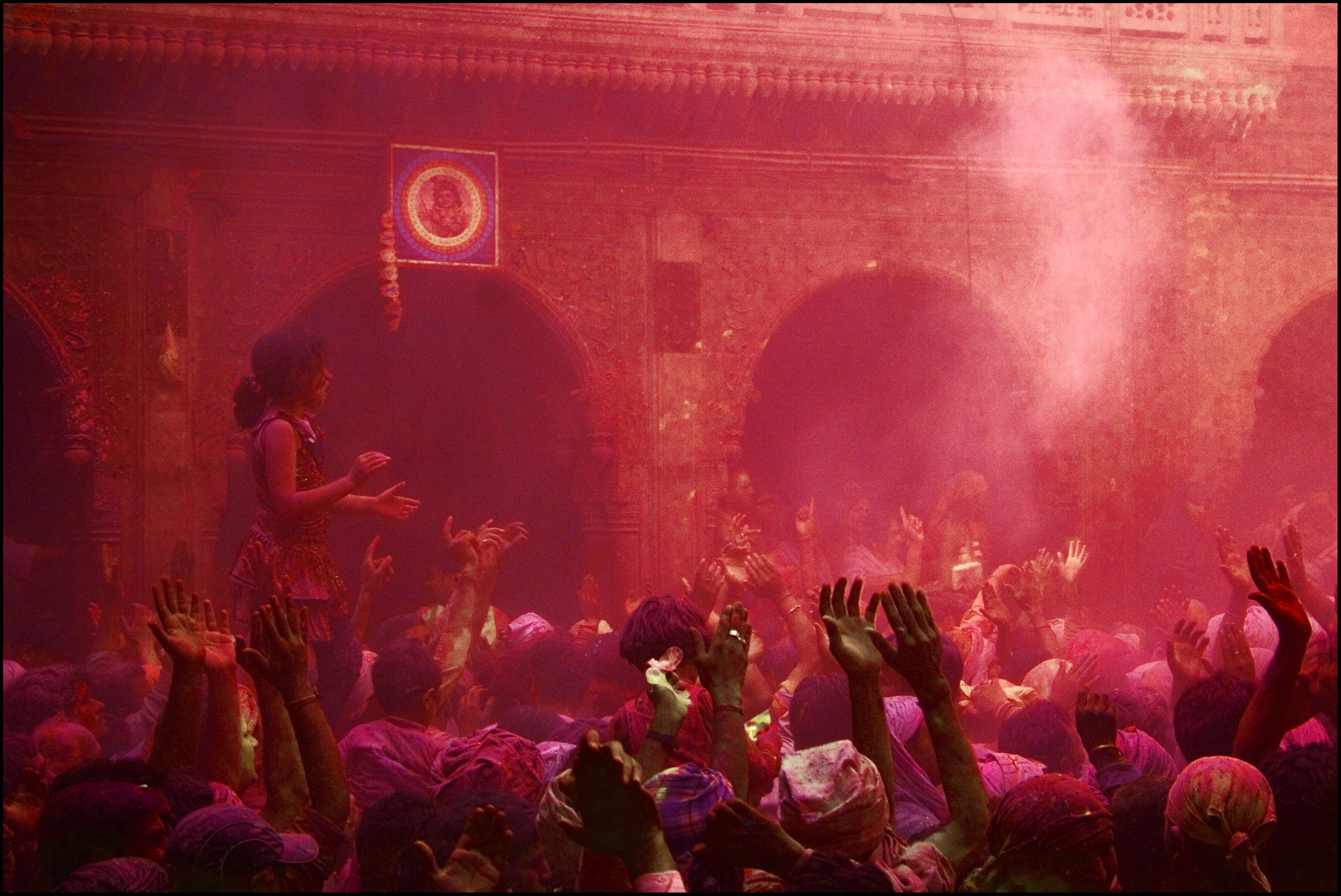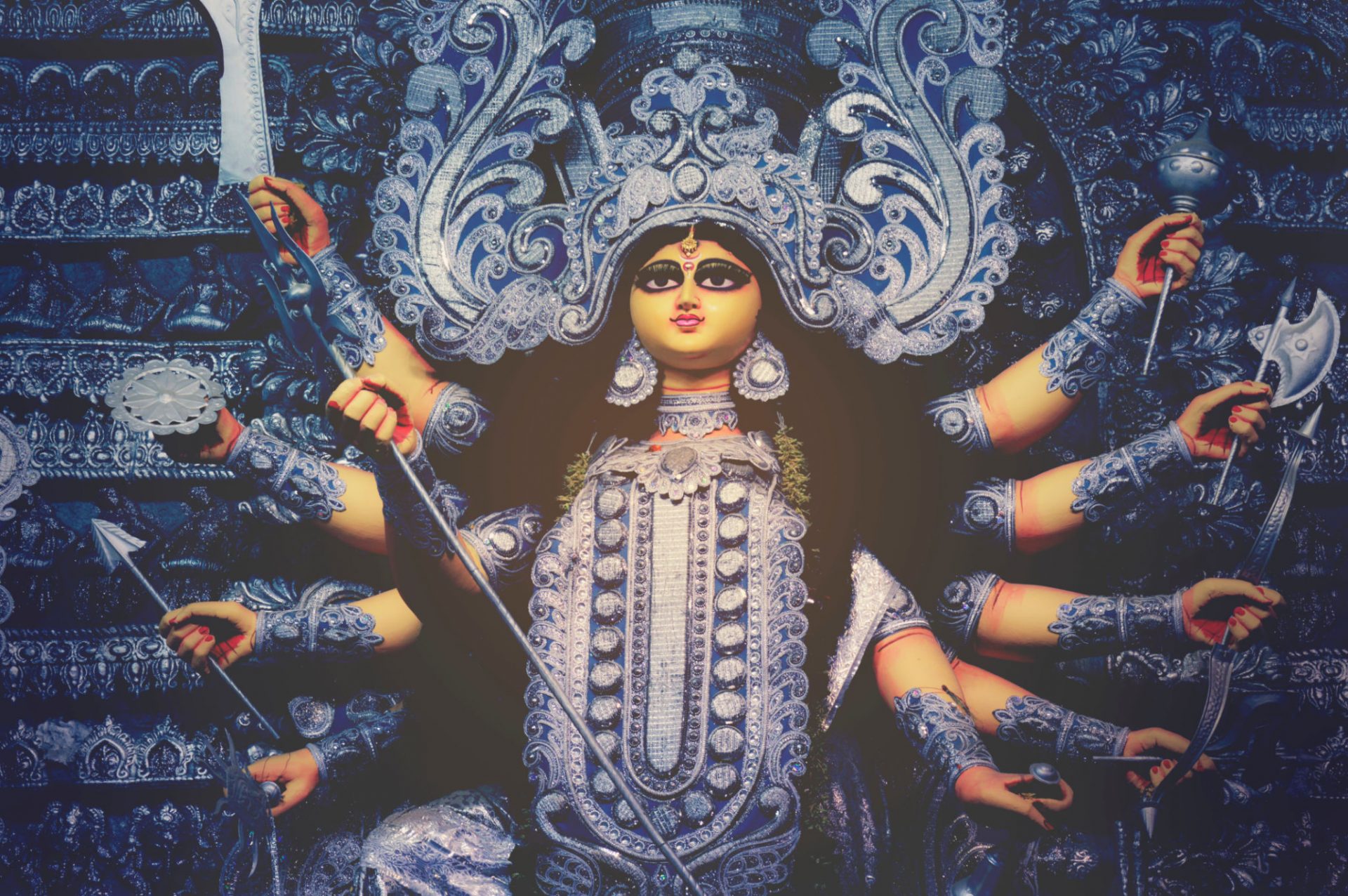Chaitra Navaratri is a popular Hindu festival celebrated for 9 days during the Chaitra Maas, between March and April. It starts on the first day of the year as per the Luni-Solar Calendar and goes on for 9 days, ending with Ram Navami. It is celebrated in honour of the nine avatars of Shakti or Durga.
Chaitra Navaratri
Chaitra Navaratri, also known as Vasanta Navaratri, marks the auspicious beginning of the year as per the Hindu Lunar Calendar. ‘Nava’ means nine and ‘Ratri’ means night. The festival continues for 9 nights, celebrating and honouring the nine forms of Ma Durga or Ma Shakti. Each of the nine days of the festival is dedicated to one of the nine forms of Durga, in the order of Shailaputri, Brahmacharini, Chandraghanta, Kushmanda, Skandamata, Katyayani, Kalaratri, Mahagauri and Siddhidatri. The first day is celebrated as the New Years Day across various communities in India, for Maharashtrians, it is Gudi Padwa, for Telugu community, it is Ugadi and for Assamese it is Bihu. The eighth day is celebrated as Ashtami and the 9th day as Ram Navami, bringing a joyful and glorious end to the festival. There are four types of Navaratri celebrated in a year with two being Gupt Navaratris and 2 being more popularly celebrated. These four Navaratris fall in the following months:
| Navaratri | Month |
| Chaitra Navaratri | March / April |
| Asadh Gupt Navaratri | July |
| Sharada Navaratri | September / October |
| Magha Gupt Navaratri | February. |
Out of the four, Chaitra Navaratri and Sharada Navaratri are the ones that are enthusiastically celebrated across the country.
Deities associated with the festival:
The festival celebrates the feminine form of energy, Shakti in nine different avatars.
The first night is dedicated to Shailaputri, which means the daughter of mountains. Shailaputri is the daughter of Hemavana, the king of Himalayas and is more popularly known as Parvati or Sati. Riding a bull, she is considered as the mother of nature and purest avatar of Durga, holding a trisula that represents past, present and future, and a lotus representing purity.
The second night is dedicated to Brahmacharini, meaning the one who practises austerity. She is an embodiment of grace, holding a rudraksh mala in one hand and a kalash in the other. She is known as the way to moksha.
The third night is dedicated to Chandraghanta, who represents peace and prosperity. Chandra resides in her forehead in the shape of a bell. She has three eyes, 10 hands carrying weapons and rides a lion, ready to battle against evil.
The fourth night is dedicated to Kushmanda, meaning, creator of the universe and is believed to bring light into the dark cosmos. She, like other forms of Durga has 8 to 10 limbs carrying different holy objects and weapons in each and rides a lion, symbolizing strength and courage.
The fifth night is dedicated to Skandamata, meaning mother of Skanda or Kartikeya. She rides a lion and has four hands, holding an infant skanda in the upper right arm and a lotus in the upper left arm. Her lower left hand is raised to bless the world and the lower right hand also holds a lotus, showing her calm and peaceful form.
The sixth night is dedicated to Katyayani who is a fearsome Goddess with 18 arms holding weapon in each. Riding a lion, she emanates radiant light from her body absolving all darkness and evil.
The seventh night is dedicated to Kalaratri, also known as Shubhamkari or the one who does good. She is a fearsome form with three eyes, four hands and dark complexion. She holds vajra, and a dagger, always ready to fight evil.
The eighth night is dedicated to Mahagauri who is extremely beautiful clad in white clothes and riding a bull. She holds a trisula in her right upper hand and a damru in the left upper hand. She is known to wash all sins from past, present and also future.
The ninth night is dedicated to Siddhidhatri, a giver of supernatural power. She is seated on a lotus and has four arms holding a trisula, Sudarshan chakra, a conch shell and a lotus. She grants wisdom to all who worship her.
Origin and significance:
According to Devi Bhagvata Purana, Ma Durga was the creator of the universe and Chaitra Navaratri signifies this creation. She is the epitome of Shakti and believed to be the origin of all existence. She is also known as Jagatjanini which means the one who gave birth to the universe. The festival celebrates nine forms of Durga, the Jagatjanini, revering the power and grace of the feminine energy. Chaitra Navaratri celebration starts from the first day after amavasya, symbolizing the victory of light over darkness. The first day is also celebrated as the new year day as per Hindu Lunar calendar with different names in different regions such Gudi Padwa in Maharashtra while Ugadi in Andhra Pradesh. Ma Durga is worshiped for nine nights in nine different forms. Worshiping Durga in these various forms gives us Shakti of various types, right from the shakti of grace and calmness to the shakti of courage and valour. Offering prayers to Ma Durga during the festival is believed to be the gateway to moksha.
According to Shiva Purana, Ma Durga is believed to have killed the havoc creating asura, Mahisasura, during these nine days, attaining the victory of good over evil. A simile to this is that flowers and fruits start to blossom during this time of the year, depicting the manifestation of goodness and power.
Customs and rituals:
The nine days are celebrated in great devotion by observing fast and doing japa every day. Special fasting food made of potato and shingada is prepared and people generally eat only satvik food or fruits on the nine days. Those who eat non vegetarian food regularly, resort to pure vegetarian food during these nine days, symbolizing sacrifice in devotion. The fast is broken on the ninth day, after completing the havan. Every day, a separate puja is performed for a separate form of Ma Durga and offerings of Sandalwood, flowers and incense sticks are made in reverence to her.
Pooja and Vidhi:
Day 1:
The day 1 marks the beginning of the new year as per Hindu Lunar calendar. Ghatasthapana is done on this day. Ghata or Kalash is the place of abode of Ma Durga for these nine days and Ghata Sthapana means, installing the Ghata for Ma to reside. This Kalash is then worshiped for nine nights of Navaratri. The sthapana is done as per the pratipada tithi, which mostly falls in the first three halves of the day. One cannot do Ghatasthapana during Amavasya or night.
After Ghatasthapana, Ma Durga is worshiped as Shailaputri on day 1. Shailaputri puja is done and Ma is believed to bless devotees with success in everything they desire to start.
The day 1 celebrations end with Chandra Darshan, which means offering prayers to the moon. People break their fast only after seeing the moon. Donations of food, vegetables, white cloth, sugar, rice etc are made to Brahmins to please Bhagawan Chandra.
Day 2:
The second day of Navaratri is full of enthusiasm for women as they clad in vibrant traditional attires, apply mehndi and accessorize with heavy jewellery. It is like a celebration of womanhood and is called Sindhara Dooj or Saubhagya Dooj.
Ma Brahmacharini is worshiped on this day. Brahmacharini is believed to be the unmarried manifestation of Parvati. She is the epitome of willpower and determination and blesses devotees with the same. People perform Brahmacharini Puja to offer prayers to Ma and seek her blessings.
Day 3:
The third day is the celebration of marriage between Bhagawan Shiva and Mata Parvati. Gana means Shiva and Gaur means Gauri. Gangaur puja is performed on this day, It is also known as Saubhagya Teej. Women hold fast and pray for long life of their husbands. In North India, the Gangaur festival is celebrated for 18 days extensively and is culminated by visarjan of Gauri image in water tank or well.
The third day is dedicated to Ma Chandraghanta by performing the Chandraghanta Puja. Ma Chandraghanta is known to bless devotees with bravery, courage and power. She also relieves her devotees from mental tribulations and physical sufferings.
Day 4:
This day is the celebration of the glory of Varad Vinayak, son of Ma Parvati. This day is celebrated as Chaturthi and people offer prayers to Ganpati in his Varad Vianayaka form. This is called Varad Vinayaka Chauth when Ganpati bestows his devotees with blessings for knowledge and success.
Ma Kushmanda is the fourth avatar of Durga and is worshiped on the fourth day of Navaratri and Kushmanda Puja is performed. She is known to be the creator of the Universe who eliminated darkness and brought light. She is said to control the solar system. Devotees pray to Ma Kushmanda on this day seeking directions and guidance in life and eliminating darkness.
The fifth day is also celebrated as Lakshmi Panchami. The murti of Lakshmi is cleaned with panchamrit and puja is done by offering coconut, flowers, banana leaves, sandalwood, supari, red thread and rice to her. Ma Laksmi is worshiped on this day for wealth and prosperity.
Day 5:
The fifth day of Navaratri is known to be Naag Panchami. Naag Panchami is celebrated because it is on this day that King Janamejaya, the son of King Parikshit and grandson of great warrior Abhimanyu, stopped the Sarpamedha yagna performed to avenge Pariskshit’s death. It was the fifth day of the Lunar calendar. On this day, the murti of Naga is worshiped and offerings of garlands, honey, milk, sesame seeds are made to the murti. People prepare kheer and offer it to snakes by placing them in front of anthills.
Ma Skandamata is revered on the fifth day or Navaratri in Skandamata Puja. This is the form of mother of Kartikeya who was chief general of army in the war against asuras. Skandamata is worshiped to attain knowledge as she is said to have the power to instil knowledge even in the illiterate.
Day 6:
The sixth day is the celebration of the birth anniversary of Yamuna, known as Yamuna Chhath. People perform Chhath puja, and those living near river Yamuna, take a dip in the holy water on this day. A strict fast of 24 hours is observed, which is broken only after performing rituals the next morning.
Ma Katyayani is worshiped on this day and devotees inherit inner strength and courage by worshiping this sixth form of Durga, Katyayani. People make offerings of Sandalwood, flowers, incense sticks while performing the Katyayani Puja.
Day 7:
The seventh day is the day of Maha Saptami when devotees worship Goddess Shakti. A sacred meal is prepared and distributed as Prasad to all visitors on Maha Saptami. The Maha Puja begins this day. Some devotees also worship Ma Saraswati on Maha Saptami.
Kalaratri Puja is performed on the seventh day as it is dedicated to the seventh form of Durga, Kalaratri. She is the ruler of planet Shani. Devotees offer prayers and seek the blessings of Ma Kalaratri to eliminate any negative influence of wrong people and evil forces in their lives. Ma Kalaratri is known to bless devotees with status and power. She is also worshiped by people who want to attain siddhis.
Day 8:
The eighth day is celebrated as Durga Asthmai, a day when massive murtis of Ma Durga are installed in Pandals, homes and offices. The fast or vrat observed on this day is called durga Ashtmi Vrat and the one who observes this vrat with complete surrender and devotion is known to be blessed with success and good fortune. Durga Chalisa is recited on this day in rememberance of Ma Durga.
Kanya Pujan is a special feature of this day when young girls who have not reached puberty are offered special bhog comprising of chana, puri and halwa and are paid respect to, by cleansing of feet, by older women, as a reverence of Ma Durga.
Annapurna Ashtami and Sandhi Puja are also performed on this day.
Mahagauri Puja is performed on this day to worship the eighth form of Ma Durga, Mahagauri. Devotees are blessed with serenity and peace. They observe fast and seek the blessings of Mahagauri and some also end their Navaratri fast on this day.
Day 9:
The grand 9 nights long festival culminates on this day and is celebrated as Ram Navami. Lord Rama is believed to have born in the middle hours of Hindu day and the puja, known as Madhyayan puja is performed during this time only. The vrat on this day is called eight prahar vrat, which means from sunrise to the next sunrise. Fasting that is done without any particular desire in mind is called Naimitikka and the one which is observed with a particular desire in mind is known as Kamya.
The form of Durga worshiped on this day is Siddhidhatri and devotees worship Ma Siddhidhatri to attain siddhis and powers and wisdom.
Celebrations across India:
The Chaitra Navaratri festival is celebrated by all Hindus alike. It is extensively celebrated in North India and Maharashtra as a grand festival. The first day of the Navaratri is celebrated as Gudi Padwa in Maharashtra. In North India, the Chhath Puja and Ram Navami are celebrated most enthusiastically. Durga Ashtami is celebrated with equal fervour throughout India.
Benefits:
Celebrating Navaratri is celebrating womanhood. Celebrating Navaratri is celebrating the power of feminine energy. The Navaratri festival is an opportunity to seek blessings from nine forms of Durga which are quintessential for a wholesome life.




